|

An Immensely Successful Event
THOMAS BIELINSKI reports from the
West Cork Chamber Music Festival 2009
Home to the most scenic of Irish landscapes, Bantry played host to the fourteenth annual West Cork Chamber Music Festival [27 June until 5 July 2009, County Cork, Ireland]. An area embroiled in wars and steeped in history, Bantry is a charming maritime town and lays claim to Bantry House -- one of Ireland's most spectacular stately homes. Right in the path of the gulf stream, a most curious humidity found its way into Ireland's characteristic showery and mild summer weather. And what appears as a large lake enclosed within Ireland's verdant glory, though with the familiar scent of seaweed, is a bay at the crossroads with the vast Atlantic.
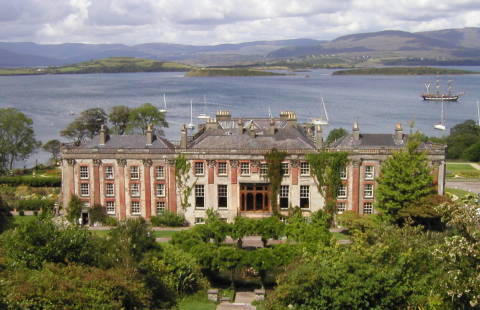
Bantry House
|
On the morning of Thursday 2 July 2009, the festival had been underway for a number of days, and judging by the turnout and climate of the day's morning talk, it was brimming with enthusiasm. The atmosphere was unique -- not often are audiences treated with the performers' presence. Not only were the renowned performers giving extensive insight into the works for performance, but they answered all questions raised, and before long the talks resembled something more akin to a discussion, and the keen audience felt rightly privileged. The pianist Alexander Melnikov had no qualms with disclosing his apprehensions at programming Shostakovich's twenty-four preludes and fugues, even though he had received a standing ovation for his performance of them earlier this week. And following an insightful discussion by the Danel Quartet, few would be missing out on their performance of Weinberg's String Quartet No 4 later that evening.
Trio Mediaeval [sopranos Anna Maria Friman, Linn Andrea Fuglseth and Torunn Østem Ossum] were on first for the morning's coffee concert at St Brendan's church. This music was well attuned to the church's stark interior, the bare fifths and quaint modally-tinted cadences conjuring up the austerity of the mediaeval sound world. The three Scandinavians presented a curious choice of repertoire. A cursory glance could have one assume that this chamber festival didn't venture anywhere before the baroque, so this early repertoire came as a genuine delight.
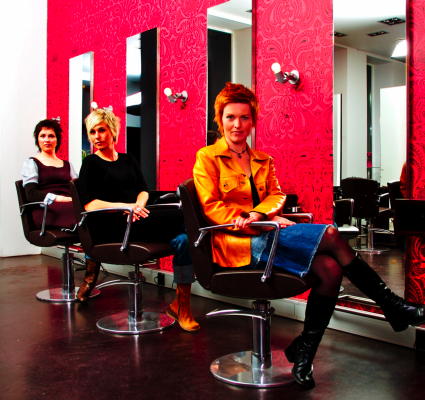
Trio Mediaeval
|
Perotin was the main feature here, alongside several anonymous composers. The Ile de la Cite, upon which Paris was founded, was evoked in Messe de Tournai's beguiling hour's-worth, and was an eye-opener in many a sense. The extraordinarily varied scope of vocal techniques required here breaches the bounds of what we have come to associate with this period. This window into the pre-renaissance culture at Notre Dame revealed many of the idiosyncrasies of the then fledgling polyphonic style of composition. Some of the 'Amens', for instance, were written to a most excessive degree, and oddly enough brought to mind the kind of excessive ornamentation which would reach its zenith in the baroque, several centuries later.
Trio Mediaeval's sensitivity to the ebb and flow of each phrase, carving out the 'framework' within this body of sound, did much to give the a capella style good support. And thereby the whole corpus of variegated techniques and deliberate nuances could be discerned within the somewhat uniform style.
For all the inordinately extensive amens, the exchange of voices in the most peculiar of manners -- little would most know that this period constituted such a wide variety. But had the above maneuvers come as no surprise to the cognoscenti, then perhaps the notion of singing three verses simultaneously may, which was the case with Ite Missa Est. Whether or not Trio Mediaeval was faithful to mediaeval practice is another point, though of little import when treated to finely coordinated musicianship.
That Perotin and his contemporaries ware regarded as little more than artisans -- in other words more akin to craftsmen -- may come as a surprise. Nonetheless, turning to Beethoven's Wind Octet that followed, we have music that cannot pass for anything short of sheer artistry. The advancements of composition by Beethoven's time mirrored that of society too. Optimism, equality, the apogee of humanity that was the enlightenment, were qualities that sounded out from this performance.
Embodying all these qualities, this was humanitarian music in every sense, the music of the people, and the performance bustled with moments of electrifying energy, expectation-generation and the like. So incredibly had the musicians maximized on the classical rhetoric that the final chord brought about a lengthy sigh of exhilaration from the audience.
Consummate in all respects this octet were, and though it shouldn't be any true measure, it is worth pointing out that there was not one wrong note or slip to be heard. A musician's ego can get carried away all too easily in such circumstances, but this is a chamber music recital after all, and each musician did their part for the greater whole, attaining perfectly balanced and pristine ensemble work. [Nora Cismondi and Emma Schied, oboes, Romain Guyot and Jerôme Laferièrre, clarinets, Hervé Joulain and Jean-Philippe Chavey, horns, and Laurent Lefèvre and Chiara Santi, bassoons.] A most unexpected yet delightful coupling this had proven to be.
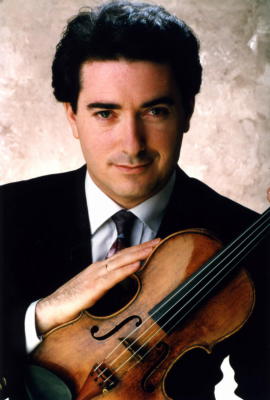
Hagai Shaham
|
The following concert commenced in the afternoon. It was held at St Brendon's again, and it featured the Israeli-born violinist Hagai Shaham alongside the pianist Jeremy Menuhin.
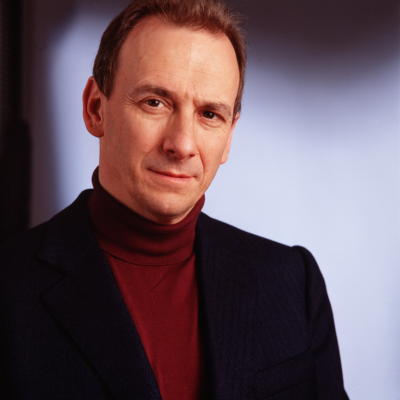
Jeremy Menuhin
|
As the son of the celebrated Yehudi Menuhin, it would be a given that Jeremy should be expertly acquainted with the dynamics of the violin, and could bring this experience to bear on his role as accompanist. Restrained nobility, grace and poise, the very essences of the Classical style, were ever-present in Mozart's Violin Sonata in G major with both performers. It is worth noting that this work was written during the first year of Mozart's freelance career.
Debussy's Violin sonata in G minor followed. Again, written at a critical stage of the composer's life, though in this case his penultimate year. Debussy would soon pass away, only to hear bombshells attacking Paris. The great war would bring about an inevitable modernism, a far cry from Debussy's innovations that were regarded as progressive. After all, though he represented what we have come to know as impressionism, the prominence and immediacy of subjective expression was still part of the romantic aesthetic. Hagai Shaham and Jeremy Menuhin rendered such moments accordingly.
By the end of the sonata the duo had commanded rapt attention from the audience, and the momentum intensified with Brahms' third violin sonata in D minor. Jeno Hubay's Scènes de la csárda No 4 'Heyre Kati' embodied the same gypsy soundworld encountered with Brahms' famous numbers, but most will be entirely surprised at their ingenuity, not to mention the full-blooded finish which sent the momentum right through the roof. Had Hubay been more prolific in other compositional genres, one wonders whether these may have come to be regarded as worthy contenders for Brahms' Hungarian Dances.
It is indeed impressive, upon entering the fourth of five concerts this day, to find Bantry House fully booked. The house, after all, can hold a large number of people. But upon entering the house, one immediately sees the appeal in the location. Just a stone's-throw away from the ocean, boasting spectacular gardens, it overlooks Bantry bay. Here resided a succession of earls, whose descendants still occupied the home to this day. The vistas and gardens are themselves something of a gem.
Literary classics from Wilde to Pushkin padded out the stately interior along with an eclectic set of furniture acquired over the years, amongst which we were seated. Now this was a setting germane to the repertoire of a chamber music festival. But there was clearly more to the courtly repertoire that had set the tone thus far.
Weinberg's fourth quartet was featured first. The Danel Quartet, who had given their erudite yet enlightening discussion earlier that morning, had mentioned their brief contact with Weinberg himself. But a lack of acquaintance with Weinberg's output had me skeptical. Post-tonal music and Soviet Russia under the strains of socialist realism left ample room for music that can at times seem entirely arbitrary, and whose integrity can be questioned. But how misguided I was. Yes, the music sounded like the late Shostakovich sound world and yes, the sound world was a far-cry from harmonious tonality, but no sooner had an eerily clinical ten minutes passed than the logic of the music began to unfold and entrance. Whether it was the musicians or the music I still can't figure, but it was as though the music tapped straight into our subliminal consciousness. In this state the music was understood on its own terms, and for all the full-blown atonality which permeates much of the work (although a fair part can still be seen to rely on tonal techniques), the atmosphere was one of a mesmerised audience. We were one, connected directly with the language of this composer. There were one or two moments where the Danel's intuitions, sound and intellect coalesced into a terrific experience that transcended any attempt at 'informed listening' and communicated only with the immediate.
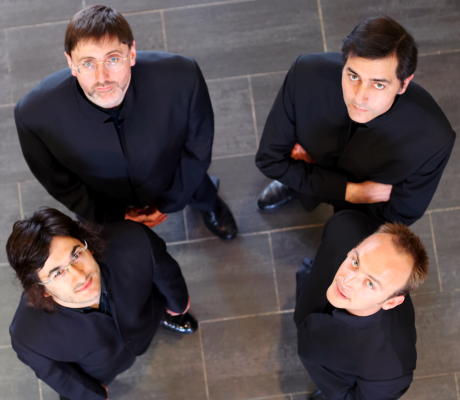
Quatuor Danel. Photo © 2007 Derek Trillo
|
Of all mediums it is that of the string quartet that best represents our most intimate and base emotions, and the Danel Quartet brought across the unmitigated sardonic moments with transparency, and were forthright in the most unsettling anxiety of the second movement, the stupefying apotheosis of the third movement, and the outright rampancy of the finale. At times the music could only rely on the barest of motifs for coherence as all other parameters disintegrated. And these motifs were profound. Certainly this was the highlight of the day.
Following this, the Georgian composer Giya Kancheli premièred his work Ninna Nanna, which was of a similar aesthetic. He congratulated the musicians [flautist Janne Thomsen and the Danel Quartet] in person, and was genuinely pleased. The Archduke Trio that followed [played by Hagai Shaham, violin, Marc Coppey, cello and Alexander Melnikov, piano] was a success and concluded the evening aptly.
The sun shone over Bantry on the fine morning of Friday 3 July 2009, and Mozart's overture to The Marriage of Figaro, a cornerstone of the operatic repertoire, started the day. [Coffee Concert at St Brendan's Church, featuring oboists Nora Cismondi and Emma Schied, clarinettists Romain Guyot and Jerôme Laferièrre, basset horn players Philippe Berrod and François Lemoine, horn players Hervé Joulain, Jean-Philippe Chavey, Sylvain Guillon and Fabian Borchers, bassoonists Laurent Lefèvre and Chiara Santi, and double bass player Niek de Groot.]
Written originally by the French writer Pierre Beaumarchais, Le mariage de Figaro was banned from the Viennese stage. In the wake of the French political instability soon to take its toll in form of the revolution, any satirization of aristocracy was condemned by those of that class. These historical facts have a direct link to Bantry, where repercussions of the revolutions were sorely felt.
Shortly after the French and American Revolutions, in much the same spirit, the people of Ireland sought to overthrow the English rule, then by George III. And it was here in Bantry bay that Theobalde Wolfe Tone -- father of Irish republicanism -- accompanied some fifteen-thousand French troops who arrived at Bantry Bay. Hence the town square is named after him. The coup would prove futile however, and Wolfe Tone remarked that 'England has had its luckiest escape since the Armada'. But this was not to be the end of the Irish revolutions, as this city would also be active during the Irish war of independence some hundred and twenty years later.
The Overture to The Marriage of Figaro qualifies as a concert piece in its own right, and the ensemble artfully conveyed the essence of the work's comical nature. The calculated drama was handled with care, for it is, after all, Mozart's integration of his unequalled compositional mastery as a means to serve his dramatic purposes, which set him apart from his contemporaries. The vivacious opening motif had set us straight into gear, ready for all the wit and mischief that would ensue. We were treated to an invigorating performance.
With Mozart's Serenade in B flat, the spirit of the enlightenment was again palpable. The musicians were determined to imbue the audience with the full stock of revolutionary sentiments and Wolfe Tone's spirit was indeed manifest. I even caught several members of the audience conducting to the music -- this was the kind of raw spirit that the performance elicited. The enlightenment has left us with many a social contract, Rousseau and the like, and a contract was certainly evident here but of another kind, that of the audience's possession of their musicians -- they wouldn't have them leave the stage until they had been called back five or six times!
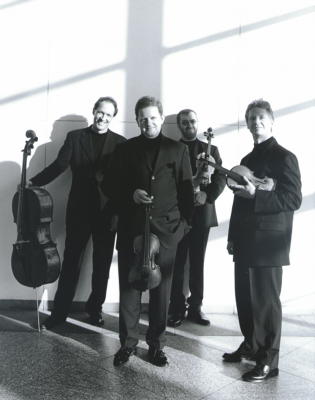
The Vanbrugh Quartet
|
At the main evening concert, again at Bantry House, the RTÉ Vanbrugh Quartet performed Michael Doherty's String Quartet No 2. By comparison to the Weinberg quartet of last night, this was a contemporary work. From the first moments it was obvious that RTÉ Vanbrugh were to give us a worthwhile performance, and it was duly ravishing. The second work, the piano trio Episodi e Canto Perpetuo by Peteris Vasks, played by the Storioni Trio, may have been challenging to some by its length and unabashed cacophony, but this was to be complemented by Brahms' second Piano Quartet in A, with a starkly contrasting sound-world. Jeremy Menuhin did another fine job in accompaning the strings of Hagai Shaham, violin, Jennifer Stumm, viola and Marc Coppey, cello.
At the late night concert on Friday 3 July 2009, Lera Auerbach gave the Irish première of her own 24 Preludes for Piano Op 41, sequenced in the same order as Chopin and Shostakovich. At times she was still and proud, yet at others entirely possessed -- almost appearing like the music she was creating. We were so enthralled that we insisted on an encore.
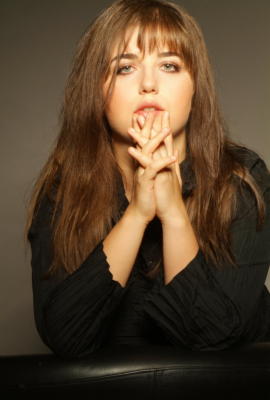
Lera Auerbach. Photo © F Reinhold
|
Having been here for only two days, I can only regret to have missed that which preceded my arrival. This well-balanced choice of repertoire, enchanting location, and the entertaining and comprehensive concert notes by Francis Humphrys all added together to make an immensely successful event.
Copyright © 11 July 2009
Thomas Bielinski,
London UK

BANTRY WEST CORK CHAMBER MUSIC FESTIVAL BANTRY HOUSE ALEXANDER MELNIKOV STRING QUARTET CHAMBER MUSIC LUDWIG VAN BEETHOVEN WOLFGANG AMADEUS MOZART CLAUDE DEBUSSY JOHANNES BRAHMS ARCHDUKE TRIO THE MARRIAGE OF FIGARO RTE VANBRUGH QUARTET PETERIS VASKS IRELAND
|

